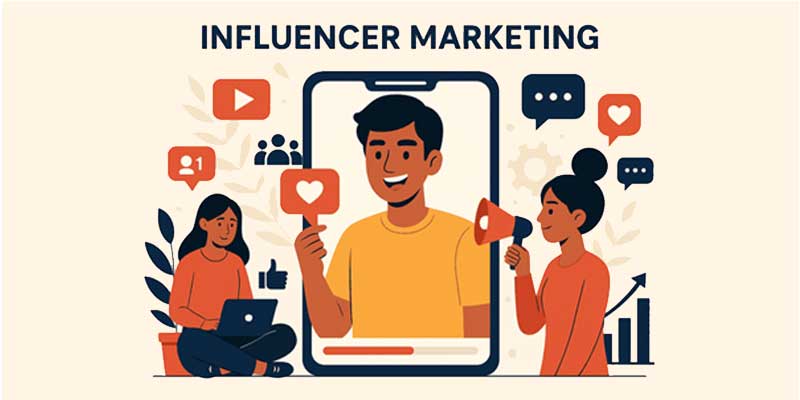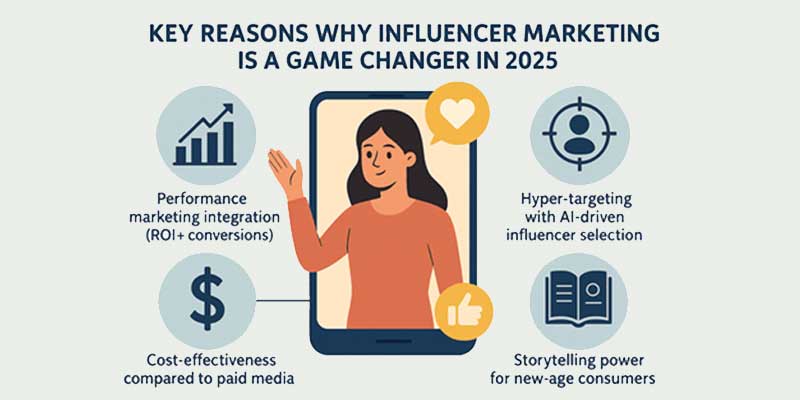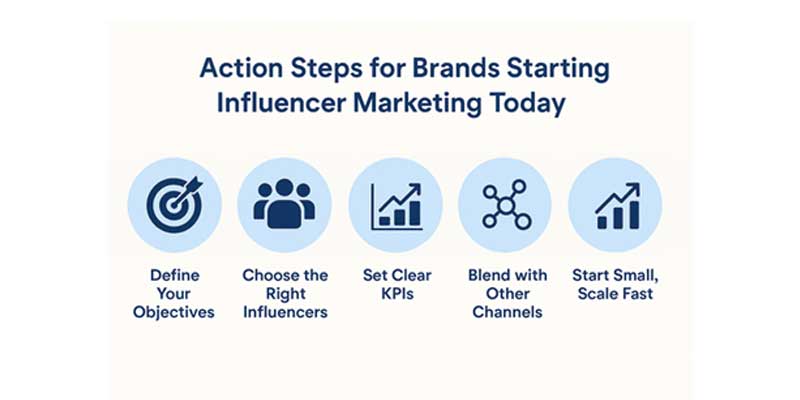

The soaring popularity of various social media platforms has changed the way we perceive digital marketing, With cut-throat competition and brands competing against each other for more visibility, creative advertising agencies in Bangalore are on the constant lookout for a game changer to gain credibility and new customers. With the combined active users surpassing 2 billion on Facebook and Instagram, businesses and as well as social media marketing agencies are keen to explore the option and leverage on a tool called Influencer Marketing.
Influencer marketing is the modern extension of word-of-mouth—only amplified through digital platforms. In 2025, consumers are more likely to trust content from creators they follow than from polished brand ads. This shift makes influencer marketing one of the most effective ways for businesses to connect with their audiences in an authentic and engaging manner. It is no longer limited to lifestyle or fashion; today, industries from healthcare to real estate are leveraging influencers to drive measurable business outcomes.
Traditionally, people relied on recommendations from family, friends, or local community leaders before making purchase decisions. Over time, this trust moved online. Bloggers, YouTubers, Instagram creators, and TikTok influencers became the new “word-of-mouth” leaders.
What makes this evolution powerful is scale—where once a conversation reached a few people in a neighborhood, digital influence allows the same recommendation to reach thousands or even millions of followers instantly. Unlike traditional media, it fosters interactive engagement, where consumers can ask questions, leave feedback, and share experiences in real time.
Traditional advertising—TV spots, print ads, billboards—pushes a message outward, often interrupting the consumer’s attention. Influencer marketing, by contrast, works by embedding the brand within content that people are already consuming and enjoying.
For example, a skincare brand promoting through a trusted beauty creator achieves more credibility than a 30-second TV commercial. Viewers perceive influencer content as advice rather than a sales pitch. This authenticity translates into higher engagement, brand recall, and conversions.
In fact, many brands are partnering with digital marketing agencies in Bangalore to integrate influencer collaborations into their broader paid and organic campaigns. These agencies help businesses measure ROI, select the right influencers, and blend influencer content with SEO, PPC, and social media for maximum impact.
Search engines show a surge in people looking for “why influencer marketing” because decision-makers want to understand not just what it is, but why it has become indispensable. In 2025, three major factors are driving this trend:
This curiosity shows that marketers no longer see influencer marketing as optional. Instead, it has become central to brand strategies, bridging the gap between authenticity and performance.
Traditional channels like TV, print, and radio advertising still play a role in branding, but their effectiveness has sharply declined in the digital-first world. Today’s consumers are hyper-connected, highly skeptical of overt advertising, and more influenced by relatable creators than by polished campaigns. Influencer marketing leverages this behavioral shift, offering authenticity, measurable ROI, and closer alignment with consumer expectations.
Celebrity endorsements used to dominate brand marketing, but audiences increasingly view them as transactional and scripted. Consumers know when a superstar is paid to promote a product, making it harder for those endorsements to feel genuine.
In contrast, influencers—especially niche creators—build credibility by sharing real experiences. When a lifestyle blogger demonstrates how a skincare product improved their daily routine, it resonates far more than a glossy billboard featuring a film star. This relatability builds trust, making influencer content more persuasive than celebrity-driven campaigns.
While mega influencers and celebrities reach millions, engagement rates with their audiences are often lower. Micro (10k–100k followers) and nano influencers (under 10k followers) have emerged as powerful marketing partners because of their tight-knit communities and authentic interactions.
Brands find that micro and nano influencers deliver higher ROI per campaign dollar, as their followers see them as peers rather than distant celebrities. This cost-effective and targeted reach is one of the biggest reasons why influencer marketing outperforms traditional ads.
Consumers in 2025 no longer take brand messages at face value. Instead, they depend on social proof—the validation that comes from seeing others use and recommend a product.
A TV ad may tell you a phone has the best camera.
But a trusted tech influencer showing night photography results on Instagram creates instant proof.
Social proof has become more powerful than brand promises because it reflects lived experiences. When buyers see “people like me” using a product, it reduces skepticism and accelerates purchase decisions.
This shift explains why influencer campaigns often outperform traditional media: they align with how modern consumers research, validate, and decide to buy.
The marketing landscape in 2025 is more competitive than ever. Brands face rising ad costs, shorter consumer attention spans, and increasing demands for authenticity. Against this backdrop, influencer marketing has evolved from an experimental tactic to a core growth strategy. Here are the key reasons why it stands out as a game changer today.
Influencer marketing is no longer just about impressions or vanity metrics—it is now deeply tied to performance marketing goals. Brands can track influencer campaigns through affiliate links, discount codes, and UTM parameters to measure actual leads, sales, or app installs.
For example:
This integration ensures influencer marketing contributes tangible ROI, allowing marketers to compare results side by side with PPC, SEO, and other digital efforts.
In 2025, artificial intelligence plays a huge role in refining influencer collaborations. AI-powered tools analyze audience demographics, psychographics, and engagement quality to match brands with the most relevant creators.
This eliminates guesswork and ensures campaigns reach precisely defined audiences—whether that’s Gen Z in Tier 2 cities, luxury buyers in metros, or niche communities like sustainable living advocates. Hyper-targeting makes influencer marketing more efficient and scalable compared to traditional broad-based media buys.
Advertising costs on Google and Meta platforms continue to rise due to competition. Influencer marketing provides a cost-effective alternative by combining reach, engagement, and authenticity in one investment.
A single influencer video can generate impressions, clicks, and conversions at a fraction of the CPC of paid ads.
Long-tail partnerships with micro-influencers often deliver more sustained brand visibility than one-off paid media bursts.
This cost-efficiency allows even mid-sized businesses to compete with bigger players, making influencer marketing a democratized growth channel.
Modern consumers don’t just buy products—they buy stories, experiences, and identities. Influencers excel at weaving products naturally into their lifestyle narratives, making brand promotions feel genuine and relatable.
For instance:
These stories don’t feel like ads—they feel like lived experiences. This storytelling advantage is what sets influencer marketing apart from banner ads or TV spots, and it’s why it resonates so strongly with Gen Z and millennials in particular.

Influencer marketing in 2025 is not just growing—it’s transforming rapidly. The strategies that worked a year ago may no longer deliver the same results today. With technological advances, shifting consumer behavior, and the rise of new platforms, brands must stay ahead of the curve. These are the most impactful trends shaping the future of influencer marketing.
One of the biggest shifts is the adoption of AI-powered influencer discovery tools. These platforms analyze data points such as follower demographics, engagement authenticity, brand affinity, and even sentiment analysis to match brands with the right influencers.
Instead of relying on vanity metrics like follower count, brands now make data-driven decisions to ensure influencers align with campaign goals. This AI-driven approach reduces risks of fake followers, improves campaign ROI, and ensures better audience-brand alignment.
In 2025, short-form and live video formats dominate influencer strategies. Platforms like Instagram Reels, YouTube Shorts, and TikTok remain at the core of consumer engagement, while live commerce is fast becoming a powerful sales channel.
This video-first shift enhances authenticity and interactivity, two key drivers of consumer trust. Brands that embrace video storytelling will outperform those sticking to static content formats.
India’s next wave of digital growth is coming from Tier 2 and Tier 3 cities, where regional language creators hold unmatched influence. Hindi, Tamil, Telugu, Kannada, and Marathi influencers are building communities that feel deeply connected to local audiences.
For brands, this means:
This trend highlights the importance of localization in influencer marketing, making regional creators a must-have in national campaigns.
Brands are shifting from short, transactional collaborations to long-term influencer partnerships. Instead of one-time posts, they now co-create ongoing campaigns where influencers become true brand advocates.
The benefits of long-term partnerships include:
This approach transforms influencers from “content partners” into strategic brand ambassadors, building stronger loyalty both for the brand and the audience.
Beyond impressions and likes, influencer marketing has proven its ability to increase brand visibility, drive conversions, and strengthen consumer trust. In 2025, brands across industries—D2C, B2B, and even legacy enterprises—are using influencers not just for reach but for measurable growth.
These examples prove how strategically chosen influencers can transform niche startups into household names by amplifying both awareness and conversions.
Unlike traditional ads, B2B influencer campaigns on LinkedIn build credibility and generate high-value leads, which is often more impactful than cold outreach or display ads.
The true strength of influencer marketing lies in its psychological impact on consumer decision-making. Audiences perceive influencer recommendations as peer-to-peer advice, leading to:
This combination of authentic awareness and conversion-driven proof makes influencer marketing an unmatched tool for brands looking to grow sustainably.
While influencer marketing is one of the most powerful tools in 2025, it’s not without its hurdles. Brands must recognize and address these challenges to ensure campaigns remain authentic, compliant, and ROI-driven.
One of the biggest pitfalls in influencer marketing is the prevalence of fake followers and bot-driven engagement. Many influencers inflate their follower counts through purchased bots or engagement pods, giving brands misleading campaign metrics.
The risks include:
To counter this, brands are increasingly using AI-powered analytics platforms that can verify influencer credibility, check engagement quality, and identify red flags before partnerships begin.
In India, influencer marketing is now regulated by the Advertising Standards Council of India (ASCI). Influencers must disclose paid collaborations clearly using labels such as #ad, #sponsored, or collaboration.
Challenges arise when:
Non-compliance can harm a brand’s credibility and, in some cases, lead to legal scrutiny. Thus, brands must establish clear contracts, ensure proper disclosures, and work with influencers who respect regulatory norms.
Unlike paid ads where ROI is straightforward, influencer marketing often suffers from attribution challenges. Did a spike in sales come from an influencer post, or from another channel running simultaneously?
Common difficulties include:
To overcome this, brands now rely on:
By making ROI measurement more precise, brands can confidently scale influencer campaigns without treating them as “trial and error.”
To transform influencer marketing from a brand-building activity into a measurable growth driver, businesses must approach it strategically. The following best practices ensure that influencer campaigns generate not only awareness but also conversions, engagement, and long-term value.
Not every campaign needs a celebrity influencer with millions of followers. The key is aligning influencer type with campaign goals:
Choosing the right mix allows brands to balance reach with relatability while optimizing cost efficiency.
One of the most common mistakes brands make is running influencer campaigns without well-defined goals. Before launching, businesses must set clear Key Performance Indicators (KPIs), such as:
Clarity in objectives ensures campaigns are measurable and aligned with business growth targets rather than vague “visibility.”
Traditional influencer contracts often revolve around flat fees, but in 2025, brands are moving toward performance-based contracts.
This approach makes influencer marketing more accountable and ROI-driven, while also motivating influencers to create content that genuinely resonates with their audience.
For maximum impact, influencer campaigns shouldn’t exist in isolation. Instead, they must be integrated into a brand’s overall digital marketing strategy to maximize results across every touchpoint.
This blended strategy ensures influencer efforts fuel multiple marketing channels simultaneously, delivering compounding returns across awareness, engagement, and conversions.
Influencer marketing is no longer just a trend—it is shaping the very future of how brands and consumers interact. As technology advances and consumer behavior shifts, the next phase of influencer marketing will look radically different from what we know today. Here are the key developments redefining the space in India and across the world.
The rise of AI-generated virtual influencers is already reshaping the industry. These digital personalities—designed with hyper-realistic visuals and controlled by AI algorithms—offer brands complete control over messaging, tone, and availability.
The metaverse and immersive technologies like AR (Augmented Reality) and VR (Virtual Reality) are opening up new influencer-driven experiences. Imagine trying on a luxury outfit in a virtual store guided by your favorite influencer, or attending a VR concert where influencers host interactive product placements.
Brands are already exploring:
As adoption grows, influencers will become key storytellers in immersive brand journeys, moving beyond posts and videos into fully interactive digital universes.
Perhaps the most disruptive trend is the rise of creator-led brands. Influencers are no longer just partners for promotion—they are building their own businesses, sometimes competing directly with legacy players.
Examples include:
In 2025 and beyond, the marketing landscape is becoming increasingly fragmented, competitive, and consumer-driven. Traditional ads alone cannot capture the trust and engagement of modern audiences. This is exactly why influencer marketing continues to stand out as a powerful, future-proof strategy. By blending authenticity with performance-driven results, influencer marketing is not just a campaign tool—it is redefining how brands build relationships with customers.
For businesses, the lesson is clear: influencer marketing is no longer optional—it’s essential. Brands that embrace influencers as long-term partners will enjoy higher trust, stronger engagement, and measurable ROI compared to those that rely solely on traditional media.
The rise of AI-powered influencer matching, regional content creators, and creator-led brands means the ecosystem will only become more dynamic. Companies that adopt early, experiment boldly, and integrate influencer marketing into their core strategies will secure a competitive edge in both India and global markets.

By taking these steps, brands can confidently begin their journey into influencer marketing, ensuring sustainable growth in a marketplace where consumer trust is the ultimate currency.